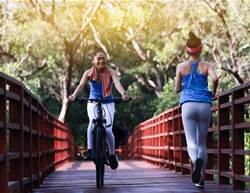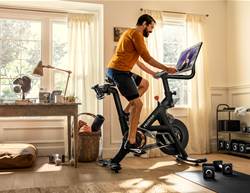Feel calmer surrounded by trees? Feel more motivated to exercise by the beach? It’s not just you. Nature can reduce our stress levels and improve our mood. Time in nature has also been associated with better brain function, blood pressure, mental health and sleep. And not only is nature the most beautiful place to exercise, it can also motivate you to exercise more.
"Outdoor workouts bring a sense of freedom and connection to nature, enhancing the overall fitness experience. It's not just about physical health but also mental and emotional wellbeing,” says Ben Lucas, founder of Flow Athletic.
But which outdoor workout is best? Here are our favourites, along with their proven mind and body health benefits.

Swimming: dive into total body fitness
Swimming is a low-impact, full-body workout that engages almost every muscle group. The resistance of the water helps build strength and endurance while being gentle on the joints.
"Swimming is a fantastic exercise for overall cardiovascular health. It works your heart and lungs, improves flexibility, and promotes lean muscle development,” says Lucas.
Swimming is a great way to burn energy, fast. Swimming breaststroke for 30 minutes burns about 1,535kJ (367cal), and freestyle burns 1,690kJ (404cal). This is more than running at a speed of 10kph for the same amount of time, which burns around 1,255kJ (300cal).
If you want to lose weight, swimming can help get your there. Research shows that middle-aged women who swam for 60 minutes three times a week lost a significant amount of body fat in just 12 weeks. They also boosted their endurance and flexibility, and lowered their cholesterol.
Swimming isn’t the only exercise you can do in a pool, either. Try these fun pool workouts.

Stand-up paddleboarding (SUP): balance and core strength
Even the most leisurely paddle on a SUP can be a complete body workout focusing on balance and core strength.
"Stand-up paddleboarding is a low-impact exercise that uses the core, shoulders, legs and even your feet,” says Vikki Weston, ambassador for Red Paddle Co and founder of She SUPS.
“The best news is that it’s not only great for physical fitness but also has heaps of mental health benefits too, as you connect with nature and lose yourself in the mindful rhythm of paddling," she says.
Want to take it up a notch? Try stand-up paddleboard yoga to really test your concentration and balance.

Running: cardiovascular powerhouse
Running remains one of the most accessible and effective outdoor workouts. It has lots of health benefits, too. Running lowers your risk of heart disease and helps you live longer. One study of more than 55,000 adults showed that runners at all levels of speed and expertise had a greatly reduced risk of cardiovascular disease and added roughly three years to their life expectancy. It also strengthens muscles, boosts mood, and enhances overall mental wellbeing.
"Running is a natural form of exercise that releases endorphins, reduces stress, and improves cognitive function. Plus, it requires minimal equipment, making it accessible to almost everyone," says Lucas.
Running is one of the most kilojoule-burning exercises out there, so it can be great for weight loss, if that’s your goal.
A large study showed that for people who have a genetic disposition toward obesity, regular jogging was the most effective exercise for controlling body mass index, percentage of body fat, and waist circumference.
Never been a runner before? Here’s how to get started.

Hiking: nature's stairmaster
Hiking combines cardiovascular exercise with the tranquillity of nature.
"Hiking is a great way to escape the hustle and bustle of daily life. It engages different muscle groups, especially in the lower body, and provides mental rejuvenation," says Lucas.
Research shows that walking can do everything from lower your blood pressure and reduce your risk of chronic diseases to boosting your brain power. Hiking levels up your usual neighbourhood stroll as the varying terrains challenge muscles and improve endurance.

Cycling: pedal your way to health
Whether on a mountain trail or a city street, cycling is a versatile outdoor workout that offers cardiovascular benefits and strengthens lower body muscles.
"Cycling is a low-impact exercise that is gentle on the joints. It not only enhances cardiovascular fitness but also builds strong legs and improves overall stamina," says Lucas.
Cycling is easy to tailor to your fitness level, too, so you might start by rolling along to nearby shops and work towards uphill sprints.
If you’re able to use a bicycle to get to work, it can be a very time efficient form of exercise, too.
Steady cycling burns about 1,200kJ (about 300 calories) per hour. If you make cycling part of your daily routine, the kilojoules soon add up. British research shows that a half-hour bike ride every day will burn nearly 5kg of fat over a year.
Mix it up
The best bit? Mixing and matching these outdoor workouts mean you’ll never get tired of exploring the outdoors and exercising at the same time.
Weston agrees, noting the importance of variety in fitness routines. "Mixing up your workouts with outdoor activities like SUP or hiking not only challenges your body in different ways but keeps exercise exciting and enjoyable."
Whether it's the rhythmic strokes of swimming, the balance required for SUP, the endurance of running and hiking or the pedal power of cycling, each of these workouts offers a holistic experience for your body, mind, and soul.
"Embrace the elements, challenge yourself outdoors, and witness the transformative power of nature on your fitness journey," says Lucas.










